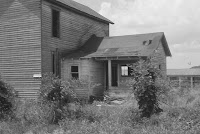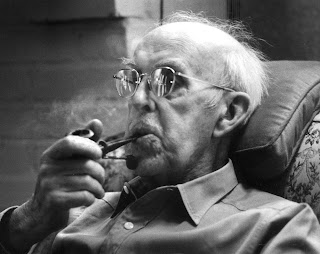By Ronald W. Kenyon
This post was originally written and uploaded on August 26, 2011. Subsequently I have written additional posts on this blog relating to the history of Abken Airport and details of my father's career in aviation.
Read this post for the background, then browse the additional posts for anecdotes about the flying adventures of my father and mother and the development of Abken Airport from its inception in 1944 to the present.
Feel free to submit your comments on any blog entry.
Revised January 16, 2017
John Warner Kenyon (1901-1998)
My late father, John Warner Kenyon [known as Warner Kenyon], was born on August 29, 1901, in Oxford, Benton County, IN, where he spent his childhood. He attended Purdue University in Lafayette, IN, where he majored in mechanical engineering. He became interested in aviation after moving to Ashland. KY, where he was hired as a draftsman for Armco Steel Corp., now AK Steel Holding Corp.
My father obtained his pilot's license in 1935; his instructor was James A. Dobyns. He bought his first aircraft, a blue Taylor J-2 Cub--registration number NC16993--at the Taylor Aircraft factory in Bradford, PA. At the time, a J-2 Cub cost $1,325.00. I remember my father telling me that the standard instrumentation on the aircraft did not include a compass; he therefore had to pay an additional $50 to have one installed.
Warner Kenyon held ratings as Commercial Pilot #36480, flight instructor and ground instructor. He entered a light plane derby at the Cleveland Air Races in 1937 and won a trophy. At one point, he considered making a career in aviation, but decided to remain at Armco, where he eventually rose to Chief Works Engineer, a position he held at retirement.
The 1937 Flood

From 1923 through 1952 and then briefly in the early 1960's an airport operated within the city limits of Ashland, KY. Known as Ashland Airport, it was located at Thirty-fourth Street, near the Ohio River. It was at this airport where my father hangared his Taylor Cub.
The devastating flood of January and February 1937 surpassed all prior floods during the previous 175 years of modern occupancy of the Ohio River Valley. Over half of Ashland was inundated, including Ashland Airport and the adjacent rail lines and the highways in and out of town. Ashland was completely isolated from the outside world and many families in rural areas of Boyd and Greenup Counties were stranded. Using one of the fairways at Bellefonte Country Club as a temporary airstrip, my father and two other local pilots, C. Giovanelli and James Dobyns, volunteered to airdrop food and supplies to those families; they also picked up and delivered bags of mail for the Post Office. My father continued his interest in aviation and eventually became certified as a flight instructor.
Crash
Photographs by Frank B. Elam
At 6:20 PM on July 31, 1943, my father had an accident at Ashland Airport. Since the airport had no underground storage tanks, fuel was delivered in 55-gallon steel drums fitted with individual pumps. Instead of aviation fuel, Standard Oil of Kentucky had erroneously delivered a drum of naphtha to the airport. Before the flight, my father topped out the J-5 Cub Cruiser from that drum. There was sufficient fuel in the line to take off, but after the plane had reached an altitude of approximately a hundred feet, the engine died and the airplane nosedived and crashed in an adjacent cornfield. In the incident, my father suffered a broken leg and student pilot Harry "Jeep" Homan a broken arm. Fortunately, both made a successful recovery.
Jeep Homan was a World War II Army veteran who served in Europe as a paratrooper from January through August 1945 with the 12th Airborne Division and then with the 82nd Airborne Division. He died in Ashland, KY, on December 14, 2010.
Following a lawsuit, my father was awarded a settlement for the injuries sustained in the crash. He had sought compensation of $10,000.00 for personal injury, $1,434.40 for medical expenses and $1,200.00 for damage to the aircraft.
Abken Airport
Around 1944 my father met Lawrence D. Abernathy, who worked as an accountant for the C&O Railway and lived in Russell, KY. Combining the first letters of their names, the two partners founded Abken Aviation Co. in 1944, and bought a 55-acre dairy farm near the Ohio River in the Melrose Addition of Worthington, in Greenup County, KY. [In researching this blog, I discovered that "Abken," is a family name of German origin. Certainly neither Mr. Abernathy nor my father knew this when they decided on the name of their company.]
The two partners built a 3,000-foot turf airstrip running approximately East-West, and constructed a large hangar-cum-office building—after plans drawn up by my father—and number of T-hangars that they rented to local pilots to house their aircraft. They named it Abken Airport. Later, they erected a galvanized steel Quonset hut. Abken Airport opened to the public on September 23, 1945. At one point in the early 1950’s Abken had some signs made up professionally; I remember accompanying my father once as he drove around Greenup County posting signs indicating the direction of the airport.
Also in 1944, my father helped found the Civil Air Patrol [CAP] squadron at Abken Airport, and rose to the rank of lieutenant colonel.
Since my father was a certified flight instructor, Abken set up a flight school and my father taught scores of returning veterans to fly under provisions of the Servicemen's Readjustment Act of 1944, known as the G.I. Bill, on weekends and holidays. The company also hired qualified former pilots as instructors.
According to my father, after World War II people were “flying crazy” because of all the movies and newsreels about the war featuring air battles. Everyone wanted to be a pilot. At one time Abken owned upwards of 18 airplanes, including various Piper models, a Stinson 108-3 Voyager, World War II surplus Vultee BT-13 and North American Aviation AT-6 trainers and even a Cessna UC-78 Bobcat, a twin-engine trainer used for training bomber pilots. I particularly remember the Stinson because it was comfortable and could accommodate all four members of my family: my parents, my brother Marc and me.
During the late 1940’s Abken frequently sponsored air shows. On one occasion, the National Guard had to be called out for security because there were so many people.
In chronological order, my father flew the following aircraft: Aeronca C-2, Taylor J-2 Cub, Aeronca-K, Piper PA-11, Piper PA-12, Aeronca Champ, Aeronca Chief, Stinson 108-3 Voyager, Bonanza, Waco, Ryan PT-22, Vultee BT-13 and North American AT-6. The last plane my father owned was a Navion, a single-engine, low-wing monoplane with retractable gear.
Ronald Kenyon (left) and Marc Kenyon (right) beside a Cessna-195 at Abken Airport circa 1953
Ashland vs. Huntington
In the period from 1948 through 1952 a competition for airline traffic took place between Ashland and the nearby town of Huntington, WV. Each city wanted the airport to be built on its side of the Big Sandy River that separates Kentucky from West Virginia. After initial negotiations broke down, each city started construction on its own project.
The City of Ashland used state and local funds to purchase the Abken runway and adjacent real estate. Abken retained the buildings and the the surrounding land it owned at the eastern end of the runway. The grass airstrip was replaced by a 5,000-foot long asphalt runway. It was opened in 1953 under the name Ashland-Boyd County Airport, even though it was located in Greenup County.
Many observers considered the Kentucky location as more suitable for airline traffic because it was located on flatland with no nearby physical obstructions. The West Virginia airport was on the top of a hill, whose summit had been bulldozed to create enough space for the runways and buildings. Nevertheless, the West Virginia location was completed first and became the hub for commercial aviation traffic in the “Tri-State Region” of Kentucky, West Virginia and Ohio.
Ashland Oil Company
Top: Ashland Oil corporate aircraft fleet 1955. Cessna 195, de Havilland Dove and Lockheed Lodestar. Bottom: Ashland Oil corporate pilots with Lockheed Lodestar. At extreme right, A. B. Berkstresser.
Ashland Oil Co., now Ashland, Inc., whose corporate headquarters were at that time located in Ashland, KY, built a large hangar and ancillary facilities at the western end of the airport to house and maintain its fleet of corporate aircraft. Abken Aviation retained the right to access and utilize the asphalt runway.
During the 1960’s Ashland Oil’s Chief Pilot was Blaine “Berkie" Berkstresser. Berkie was at the controls of the firm’s twin-engine Lockheed Lodestar when it exploded and crashed on September 4, 1962, near Ravenna, OH. All thirteen men on board, mostly Ashland Oil executives, perished in the crash, which was the worst industrial aviation accident in the nation’s history.
The Civil Aeronautics Board [now the National Transportation Safety Board] determined that the crash was caused by an electric trim tab motor that malfunctioned and pitched the aircraft suddenly downward thereby exceeded the plane’s operating limitations. The downward force caused the right wing to separate outside the right engine.
Some time during the mid to late 1960’s Ashland Oil acquired
a Douglas DC-3 for its fleet, probably as a replacement for the Lodestar. Its
tail number was N10000W.
Aviation historian and pilot William E. Martin sent me the
following recollection of an unforgettable encounter with Ashland Oil’s DC-3:
“In the spring of 1966, your father soloed me in the old J-3
Cub which I had purchased from him a few months prior. One evening I was practicing tough-and-goes.
On my last landing I touched down on the runway’s east end while Ashland Oil’s
DC-3 was touching down on the runway’s west end. Unbeknownst to me, a ‘mouse’ and an ‘elephant’
were on a collision course. Apparently
the DC-3 pilot saw me first and stopped halfway up the runway. I was slowly costing along in the three-point
position, with forward visibility about zero, when suddenly I was looking up at
the long nose and whirling propellers of the DC-3. In that split second, now knowing if it was still
moving, I stomped one ruder pedal and shot off the runway into the grass. With knees still shaking, I turned and taxied
back up the field (to the Abken end) and put the Cub to bed for the night.”
Ashland Regional Airport DWU
My father died on April 20, 1998, in Saint Petersburg, FL. Before his death, around 1980, Dick Brannock, a former Ashland Oil pilot, bought my father's share of Abken Aviation Co. He remains in partnership with Mr. Abernathy's progeny. The facility in Worthington still exists today and is known as Ashland Regional Airport [DWU]. It currently serves local charter and private aircraft.
Revised January 16, 2017. All photographs courtesy William E. Martin.


























